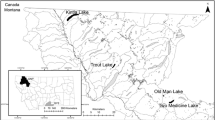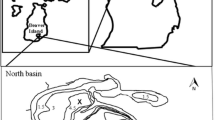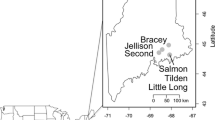Abstract
The freshwater diatom Asterionella formosa Hassall is a widely distributed species whose populations have been increasing in the recent sediments of numerous lakes worldwide. This taxon’s proliferation has commonly been associated with nutrient enrichment and, more recently, with twentieth century increases in atmospheric nitrogen deposition. However, a growing number of studies have reported increases in A. formosa in the absence of increased nutrients and have thus raised questions about whether alternative causative factors (such as recent climate warming) may be important. Here we assess the relative importance of nutrients and climate warming on A. formosa by comparing regional air temperature trends and 20 years of annually measured lake water nutrients (total inorganic nitrogen, total nitrogen, and total phosphorus) with past changes in relative abundance of this taxon from a sediment core obtained from a soft-water, Boreal Shield lake (George Lake, Killarney, Ontario). Measured lake water total phosphorus has always been very low and remains so to the present (<10 µg L−1). Total inorganic nitrogen (TIN) and total nitrogen (TN) concentrations, however, show distinct declining trends (p < 0.05) at George Lake since the 1990s, when substantial increases in mean annual and mean winter air temperatures (p < 0.01) were also recorded. These declines in lake water nitrogen concentrations match declines in atmospherically deposited nitrogen in this region. Since the late-1980s and early-1990s, there has been a marked increase in the relative abundance of A. formosa, which had been virtually absent from the lake’s sediment record in earlier intervals. A. formosa trends closely track increasing regional air temperatures, but also clearly coincide with declines in lake water nutrients and decreases in regional nitrogen deposition (p < 0.01). These trends have also occurred in other lakes in the region. Our results show that increases in nitrogen deposition and/or nutrient enrichment are not pre-conditions for increases in the relative abundance of A. formosa. Instead, warming-related changes including longer open water periods, changes in lake mixing regimes, and lake thermal properties might have contributed to the recent increase in the relative abundance of A. formosa in this lake and likely elsewhere.






Similar content being viewed by others
References
Adrian R, Wilhelm S, Gerten D (2006) Life history traits of lake plankton species may govern their phenological response to climate warming. Glob Change Biol 12:652–661
Appleby PG (2001) Chronostratigraphic techniques in recent sediments. In: Last WM, Smol JP (eds) Tracking environmental change using lake sediments, basin analysis, coring, and chronological techniques, vol 1. Springer, Dordrecht, pp 171–203
Barrow JL, Jeziorski A, Rühland KM, Hadley KR, Smol JP (2014) Diatoms indicate that calcium decline, not acidification, explains recent cladoceran assemblage changes in south-central Ontario softwater lakes. J Paleolimnol 52:61–75
Battarbee RW, Jones VJ, Flower RJ, Cameron NG, Bennion H, Carvalho L, Juggins S (2001) Diatoms. In: Smol JP, Birks HJB, Last WM (eds) Tracking environmental change using lake sediments, terrestrial, algal, and siliceous indicators, vol 3. Kluwer, Dordrecht, pp 155–190
Becker V, Huszar VLM, Naselli-Flores L, Padisák J (2008) Phytoplankton equilibrium phases during thermal stratification in a deep subtropical reservoir. Freshw Biol 53:952–963
Bennion H, Simpson GL, Anderson NJ, Clarke G, Dong X, Hobaek A, Guilizzoni P, Marchetto A, Sayer CD, Thies H, Tolotti M (2011) Defining ecological and chemical reference conditions and restoration targets for nine European lakes. J Paleolimnol 45:415–431
Bergström AK (2010) The use of TN:TP and DIN:TP ratios as indicators for phytoplankton nutrient limitation in oligotrophic lakes affected by N deposition. Aquat Sci 72:277–281
Berthon V, Alric B, Rimet F, Perga ME (2014) Sensitivity and responses of diatoms to climate warming in lakes heavily influenced by humans. Freshw Biol 59:1755–1767
Bertrand C, Fayolle S, Franquet E, Cazaubon A (2003) Responses of the planktonic diatom Asterionella formosa Hassall to abiotic environmental factors in a reservoir complex (south-eastern France). Hydrobiologia 501:45–58
Cahill KL, Gunn JM, Futter MN (2005) Modelling ice cover, timing of spring stratification, and end-of-season mixing depth in small Precambrian Shield lakes. Can J Fish Aquat Sci 62:2134–2142
Clerk S, Hall R, Quinlan R, Smol JP (2000) Quantitative inferences of past hypolimnetic anoxia and nutrient levels from a Canadian Precambrian Shield lake. J Paleolimnol 23:319–336
Dillon PJ, Molot LA (2005) Long-term trends in catchment export and lake retention of dissolved organic carbon, dissolved organic nitrogen, total iron, and total phosphorus: the Dorset, Ontario, study, 1978–1998. J Geophys Res 110:1002
Dixit AS, Dixit SS, Smol JP (1992) Long-term trends in lake water pH and metal concentrations inferred from diatoms and chrysophytes in three lakes near Sudbury. Ontario. Can J Fish Aquat Sci 49(Suppl. 1):17–24
Dong X, Bennion H, Battarbee R, Yang X, Yang H, Liu E (2008) Tracking eutrophication in Taihu Lake using the diatom record: potential and problems. J Paleolimnol 40:413–429
Downing JA, McCauley E (1992) The nitrogen : phosphorus relationship in lakes. Limnol Oceanogr 37:936–945
Enache MD, Paterson AM, Cumming BF (2011) Changes in diatom assemblages since pre-industrial times in 40 lakes from the Experimental Lakes Area (northwestern Ontario, Canada). J Paleolimnol 46:1–15
Futter MN (2003) Patterns and trends in Southern Ontario lake ice phenology. Environ Monit Assess 88:431–444
Glew JR (1988) A portable extruding device for close interval sectioning of unconsolidated core samples. J Paleolimnol 1:235–239
Glew JR (1989) A new trigger mechanism for sediment samplers. J Paleolimnol 2:241–243
Hadley KR, Paterson AM, Hall RI, Smol JP (2013) Effects of multiple stressors on lakes in south-central Ontario: 15 years of change in lakewater chemistry and sedimentary diatom assemblages. Aquat Sci 75:349–360
Hadley KR, Paterson AM, Stainsby EA, Michelutti N, Yao H, Rusak JA, Ingram R, McConnell C, Smol JP (2014) Climate warming alters thermal stability but not stratification phenology in a small north-temperate lake. Hydrol Proc 28:6309–6319
Hawryshyn J, Rühland KM, Quinlan R, Smol JP (2012) Long-term water quality changes in a multiple-stressor system: a diatom based paleolimnological study of Lake Simcoe (Ontario, Canada). Can J Fish Aquat Sci 69:24–40
Hobbs WO, Telford RJ, Birks HJB, Saros JE, Hazewinkel RRO, Perren BB, Saulnier-Talbot É, Wolfe AP (2010) Quantifying recent ecological changes in remote lakes of North America and Greenland using sediment diatom assemblages. PLoS ONE 5:e10026. doi:10.1371/journal.pone
Hundey EJ, Moser KA, Longstaffe FJ, Michelutti N, Hladyniuk R (2014) Recent changes in production in oligotrophic Uinta Mountain lakes, Utah, identified using paleolimnology. Limnol Oceanogr 59:1987–2001
Hyatt CV, Paterson AM, Rühland KM, Smol JP (2011) Examining 20th century water quality and ecological changes in the Lake of the Woods, Ontario, Canada: a paleolimnological investigation. J Great Lakes Res 37:456–469
Jaworski GHM, Wiseman SW, Reynolds CS (1988) Variability in sinking rate of the freshwater diatom Asterionella formosa: the influence of colony morphology. Brit Phycol J 23:167–176
Keller W (2007) Implications of climate warming for Boreal Shield lakes: a review and synthesis. Environ Rev 15:99–112
Keller W, Heneberry JH, Dixit SS (2003) Decreased acid deposition and the chemical recovery of Killarney, Ontario lakes. Ambio 32:183–189
Keller W, Heneberry J, McLachlan E, MacPhee S (2006) Data report: 25 years of extensive monitoring acidified lakes in the Sudbury area 1981 to 2005. Cooperative Freshwater Ecology Unit, Laurentian University, pp 152
Kothawala DN, Watmough SA, Futter MN, Zhang L, Dillon PJ (2011) Stream nitrate responds rapidly to decreasing nitrate deposition. Ecosystems 14:274–286
Labaj AL, Kurek J, Jeziorski A, Smol JP (2015) Elevated metal concentrations inhibit biological recovery of Cladocera in previously acidified boreal lakes. Freshw Biol 60:347–359
Little JL, Hall RI, Quinlan R, Smol JP (2000) Past trophic status and hypolimnetic anoxia during eutrophication and remediation of Gravenhurst Bay, Ontario: comparison of diatoms, chironomids, and historical records. Can J Fish Aquat Sci 57:333–341
Maberly SC, Hurley MA, Butterwick C, Corry JE, Heaney AE, Jaworski GHM, Lund JWG, Reynolds CS, Roscoe JV (1994) The rise and fall of Asterionella formosa in the South Basin of Windermere: analysis of a 45-year series of data. Freshw Biol 31:19–34
McLeod A.I. (2011) Kendall: Kendall rank correlation and Mann–Kendall trend test. R package version 2.2. http://CRAN.R-project.org/package=Kendall
Michelutti N, Wolfe AP, Cooke CA, Hobbs WO, Vuille M, Smol JP (2015a) Climate change forces new ecological states in tropical Andean lakes. PLoS ONE 10(2):e0115338. doi:10.1371/journal.pone.0115338
Michelutti N, Cooke CA, Hobbs WO, Smol JP (2015b) Climate-driven changes in lakes from the Peruvian Andes. J Paleolimnol 54:153–160
Palmer ME, Yan ND, Paterson AM, Girard RE (2011) Water quality changes in south-central Ontario lakes and the role of local factors in regulating lake response to regional stressors. Can J Fish Aquat Sci 68:1038–1050
R Core Team (2014) R: A language and environment for statistical computing. R foundation for Statistical Computing, Vienna, Austria. http://www.R-project.org/
Reynolds CS, Huszar V, Kruk C, Naselli-Flores L, Melo S (2002) Towards a functional classification of the freshwater plankton. J Plank Res 24:417–428
Rimet F, Druart JC, Anneville O (2009) Exploring the dynamics of plankton diatom communities in Lake Geneva using emergent self-organizing maps (1974–2007). Ecol Inform 4:99–110
Round FE, Crawford RM, Mann DG (1990) The diatoms: biology and morphology of the genera. Cambridge University Press, Cambridge
Rühland K, Paterson AM, Smol JP (2008) Hemispheric-scale patterns of climate-related shifts in planktonic diatoms from North American and European lakes. Glob Change Biol 14:2740–2754
Rühland KM, Paterson AM, Hargan K, Jenkin A, Clark BJ, Smol JP (2010) Reorganization of algal communities in the Lake of the Woods (Ontario, Canada) in response to turn of the-century damming and recent warming. Limnol Oceanogr 55:2433–2451
Rühland KM, Paterson AM, Smol JP (2015) Lake diatom responses to warming: reviewing the evidence. J Paleolimnol 54:1–35
Saros JE, Michel TJ, Interlandi SJ, Wolfe AP (2005) Resource requirements of Asterionella formosa and Fragilaria crotonensis in oligotrophic alpine lakes: implications for recent phytoplankton community reorganizations. Can J Fish Aquat Sci 62:1681–1689
Saros JE, Clow DW, Blett T, Wolfe AP (2011) Critical nitrogen deposition loads in high-elevation lakes of the western US inferred from paleolimnological records. Wat Air Soil Poll 216:193–202
Sheibley RW, Enache M, Swarzenski PW, Moran PW, Foreman JR (2014) Nitrogen deposition effects on diatom communities in lakes from three national parks in Washington State. Wat Air Soil Poll 225:1857
Solovieva N, Jones VJ, Nazarova L, Brooks SJ, Birks HJB, Grytnes J-A, Appleby PG, Kauppila T, Kondratenok B, Renberg I, Ponomarev V (2005) Palaeolimnological evidence for recent climatic changes in lakes from the northern Urals, arctic Russia. J Paleolimnol 33:463–482
Sorvari S, Korhola A, Thompson R (2002) Lake diatom response to recent Arctic warming in Finnish Lapland. Glob Change Biol 8:171–181
Spaulding S, Edlund M (2009) Asterionella. In: Diatoms of the United States. http://westerndiatoms.colorado.edu/taxa/genus/Asterionella
Stainsby EA, Winter JG, Jarjanazi H, Paterson AM, Evans DO, Young JD (2011) Changes in the thermal stability of Lake Simcoe from 1980 to 2008. J Great Lakes Res 37:55–62
Stewart KA, Lamoureux SF, Finney BF (2008) Multiple ecological and hydrological changes recorded in varved sediments from Sanagak Lake, Nunuvut, Canada. J Paleolimnol 40:217–233
Straile D (2002) North Atlantic Oscillation synchronizes food-web interactions in central European lakes. Proc R Soc Lond B 269:391–395
Thackeray SJ, Jones ID, Maberly SC (2008) Long-term change in the phenology of spring phytoplankton: species-specific responses to nutrient enrichment and climatic change. J Ecol 96:523–535
Thies H, Tolotti M, Nickus U, Lami A, Musazzi S, Guilizzoni P, Rose NL, Yang H (2012) Interactions of temperature and nutrient changes: effects on phytoplankton in the Piburger See (Tyrol, Austria). Freshw Biol 57:2057–2075
Tibby J, Reid MA (2004) A model for inferring past conductivity in low salinity waters derived from Murray River (Australia) diatom plankton. Mar Freshw Res 55:597–607
Vet R, Artz RS, Carou S, Shaw M, Ro C-U, Aas W, Baker A, Bowersox VC, Dentener F, Galy-Lacauz C, Hou A, Pienaar JJ, Gillett R, Forti MC, Gromov S, Hara H, Khodzher T, Mahowald NM, Nickovic S, Rao PSP, Reid NW (2014) A global assessment of precipitation chemistry and deposition of sulfur, nitrogen, sea salt, base cations, organic acids, acidity and pH and phosphorus. Atmos Environ 93:3–100
Wang L, Rioual P, Panizzo VN, Lu H, Gu Z, Chu G, Yang D, Han J, Liu J, Mackay AW (2012) A 1000-yr record of environmental change in NE China indicated by diatom assemblages from maar lake Erlongwan. Quaternary Res 78:24–34
Weyhenmeyer GA, Blenckner T, Pettersson K (1999) Changes of the plankton spring outburst related to North Atlantic Oscillation. Limnol Oceanorgr 44:1788–1792
Winder M, Sommer U (2012) Phytoplankton response to a changing climate. Hydrobiologia 698:5–16
Wolfe AP, Van Gorp A, Baron JS (2003) Recent ecological and biogeochemical changes in alpine lakes of Rocky Mountain National Park (Colorado, USA): a response to anthropogenic nitrogen deposition. Geobiology 1:153–168
Yan ND, Paterson AM, Somers KM, Scheider WA (2008a) An introduction to the Dorset special issue: transforming understanding of factors that regulate aquatic ecosystems on the southern Canadian Shield. Can J Fish Aquat Sci 65:781–785
Yan ND, Somers KM, Girard RE, Paterson AM, Keller B, Ramcharan CW, Rusak JA, Ingram R, Morgan GE, Gunn J (2008b) Long-term trends in zooplankton of Dorset, Ontario lakes: the probable interactive effects of changes in pH, TP, DOC and predators. Can J Fish Aquat Sci 65:862–877
Acknowledgments
The authors thank Joshua Thienpont for assistance in the field. The authors also thank Jocelyn Heneberry and Bill Keller of the Cooperative Freshwater Ecology Unit (Laurentian University, Sudbury, Ontario) for providing the monitoring data for George Lake. We would also like to thank Alex Ross for providing 2013 limnological data for George Lake. The Natural Sciences and Engineering Research Council of Canada and Ontario Ministry of Environment and Climate Change provided financial support for this project. The authors gratefully acknowledge Kathryn Hargan, Katherine Griffiths, Neal Michelutti, Euan Reavie, Tom Whitmore and two anonymous reviewers for helpful comments on earlier drafts of this manuscript.
Author information
Authors and Affiliations
Corresponding author
Electronic supplementary material
Below is the link to the electronic supplementary material.
Supplementary Figure 1
The 210Pb activities (solid circles) and estimated 210Pb dates (open circles) with associated errors for George Lake are plotted against core depth. The average 214Bi is presented using a vertical dashed line. The calculated CRS dates for the top 14 cm and associated errors are presented in the inset table. (PDF 644 kb)
Rights and permissions
About this article
Cite this article
Sivarajah, B., Rühland, K.M., Labaj, A.L. et al. Why is the relative abundance of Asterionella formosa increasing in a Boreal Shield lake as nutrient levels decline?. J Paleolimnol 55, 357–367 (2016). https://doi.org/10.1007/s10933-016-9886-2
Received:
Accepted:
Published:
Issue Date:
DOI: https://doi.org/10.1007/s10933-016-9886-2




